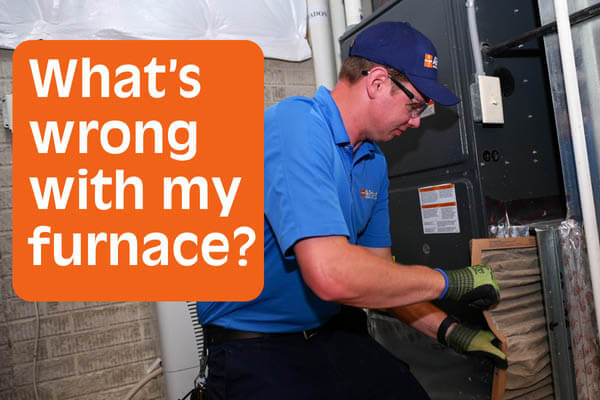Dangers of a Cracked Heat Exchanger: What to Watch For

A cracked heat exchanger is a common furnace problem that may come as a surprise to homeowners during a routine furnace inspection. If an HVAC professional has told you that your furnace has a cracked heat exchanger, you need to take action. Yet because this problem requires a full replacement of your furnace, you may be tempted to ignore it. After all, the furnace is still functioning, right?
Be warned: a cracked heat exchanger can put you and your family at serious risk. Don’t pretend the problem away. Instead, read on for our tips on spotting furnace heat exchanger cracks, preventative measures you can take, and what you can do as soon as you suspect a crack to protect your home’s residents.
Heat Exchangers in Heating Systems
The first part of keeping your family protected from the dangers of a cracked heat exchanger is understanding what this piece of equipment does, and how it functions in your home. Heat exchangers are found in most HVAC systems, including air conditioners, heat pumps, and gas furnaces.
The Role of a Heat Exchanger in Your Furnace System
The heat exchanger is the part of the furnace that exchanges the heat between the return air from your home and the hot exhaust coming from the furnace’s combustion chamber. This is what heats the air before it returns it to your home, keeping your family warm and cozy.
Between these two air masses is a sheet of metal or some metal tubing that allows the exchange of heat but not the exchange of gases. This way, carbon monoxide and other gases stay out of the air in your home.
What Happens When a Heat Exchanger Cracks?
When an HVAC system sustains damage or has extreme wear and tear due to corrosion, buildup, or lack of maintenance, cracks can form within the tubing or panels that surround the heat exchanger. These cracks then allow combustion gases to escape whenever the heat pump or air conditioner is in use. When a crack is formed in your heat exchanger, the furnace is still likely to continue working, but every time it runs, these gases enter your home.The Dangers of a Cracked Heat Exchanger
Of course, you already know that breathing in gases that aren’t meant to be inside your home isn’t good for anyone, but just how dangerous is a cracked heat exchanger? We’ll look at some of the most harmful consequences of operating your furnace with heat exchanger cracks.
Carbon Monoxide Poisoning
A cracked heat exchanger provides a place for dangerous carbon monoxide to leave the furnace and enter your home’s air. Even just a tiny crack can be large enough to allow gas to escape. While the CO levels may not be high enough to trigger your CO alarm, they can be high enough to cause headaches and other illnesses, which may seem to have no explanation.
Extreme CO leaks can cause death in mere moments, but slow leaks are just as dangerous. Over time, individuals with carbon monoxide poisoning can develop cognitive issues, memory loss, depression, anxiety, and vestibular problems. Many people report feeling unexplained flu-like symptoms, only to later discover low levels of CO gasses leaking steadily into their home.
Fire Hazards
A cracked heat exchanger leads to problems in the combustion chamber. Gases escape from where they aren’t supposed to, and the buildup of these gases causes sparks that can ignite into flames. This is especially dangerous if you have any flammable materials or debris near your furnace.
Beyond igniting nearby items, cracks in the heat exchanger can also cause other fire concerns. If your natural gas furnace overheats, escaping gas through the heat exchanger cracks can spark a blaze. There’s also something called flame rollback, in which the flame inside your furnace rolls back toward the fuel source — the escaping natural gases emitted by the crack — and starts a fire.
Reduced Furnace Efficiency
Natural gas is a precious resource, but a cracked heat exchanger will allow varying amounts of that gas to leak out, costing you money and wasting this pricey commodity. However, the danger here is about more than your pocketbook — a cracked heat exchanger has to work much harder, which means it runs more frequently. That increases your risk of fire and carbon monoxide poisoning exponentially.
Premature Furnace Breakdown
While small stress cracks — when caught early — may be able to be repaired, they still indicate a lack of maintenance or another need within your HVAC system. This may be your first warning that your furnace is at the end of its lifespan. More significant cracks in the heat exchanger nearly always require the entire furnace unit or heat pump to be replaced.
Signs Your Heat Exchanger May Be Cracked
If you think you might have a cracked heat exchanger, knowing what to look for will be the best way to minimize the damage and protect anyone who lives in or visits your home.
Unusual Furnace Smells
Most people report that a cracked heat exchanger leaves a noticeable and unpleasant odor in the air, comparable to formaldehyde. Formaldehyde has a sour, vinegar-like smell that some people compare to pickles mixed with burnt matches. Human noses can detect this odor in very small amounts, but as soon as it’s noticed, it’s critical to take swift action and exit the home.
Soot Build-Up
If you find black, powdery residue on or around your furnace, you may be looking at soot buildup from a cracked heat exchanger. The soot may appear on the heat exchanger itself or on any nearby surface.
Physical Cracks or Corrosion
Often, you’ll be able to spot a crack or a corroded spot on the heat exchanger without any other signs being present. If you do see a visible crack or hole, call an HVAC technician immediately.
Strange Noises
All furnaces make some noise when they’re running, but if you hear anything that sounds out of the ordinary — enough that it grabs your attention and sounds unusual — pay attention. It’s very common to hear banging or rattling noises when your heat exchanger is cracked, so once you’ve noticed the sound, it’s time to call in help.
Operating Issues
It may start out as simply wondering if colder temperatures are to blame for your furnace being unable to keep up, but if you notice that it’s running more frequently, not cycling off, and/or your home isn’t staying up to temperature, a cracked heat exchanger could very well be to blame.
Be sure you pay attention to how your furnace is operating, but also keep an eye on your energy bills. Even a small leak can cause a big hike in your utility prices. If you see an unexpected surge, start looking for other signs of an issue.
CO Detector Alerts
If you have a carbon monoxide detector that’s beeping and indicating higher than normal CO levels in your home, it’s time to get out. Carbon monoxide can be life-threatening, especially when left unchecked.
If your home CO monitoring system is fine, but you still suspect a crack or a leak, you can place a portable monitor near your furnace and see if it shows elevated CO levels. If it does, call a professional right away.
What To Do if You Suspect a Cracked Heat Exchanger
If all of this information leads you to believe you do, in fact, have a cracked heat exchanger in your gas furnace or heat pump, there are several steps you can take.
Turn Off the Furnace Immediately
No matter what the temperature outside is, your first step is to shut off the furnace completely. This will stop the CO from leaking into your home and lessen the risk of fire. If your carbon monoxide detector is sounding, open windows and doors, and make sure no one is in the home until an HVAC technician can assess the situation.
Contact a Certified HVAC Professional
Reach out to a trusted HVAC partner to take a look at your furnace, and let them know you suspect a cracked heat exchanger. Unfortunately, heat exchanger cracks are not DIY problems. Calling a trained and qualified professional is crucial to ensure the proper function and safety of your furnace.
Test for Carbon Monoxide Levels
Be sure to tell your HVAC technician if you’ve noticed elevated CO levels. Even if you haven’t, ask them to check for elevated carbon monoxide when they assess your furnace.
Remember to test your CO detectors regularly, swap out batteries, and keep them in key areas of your home (usually bedrooms and central locations). Do not reenter your home until CO levels are back to normal.
How To Prevent Heat Exchanger Cracks
Cracked heat exchangers are bad news, but the good news is that this type of damage is easily preventable. Here’s what you can do to help prevent cracks:
- Replace your air filter regularly (every three months). Dirty air filters are one of the top causes of heat exchanger cracks.
- Have a professional inspection and tune-up at least once a year with a qualified HVAC technician as part of your preventative maintenance.
- Perform routine furnace maintenance, including cleaning, visual inspection, clearing away any debris around the unit, and checking your vents and ductwork. Regular maintenance is the easiest way to prevent damages.
- When in doubt, call in a professional to check for issues with airflow, incomplete combustion, malfunctioning thermostats, and more.
- Never be afraid to ask for a second opinion.
Is It Time to Replace Your Furnace?
Some small cracks may qualify for furnace repair, but you’ll need to keep a close eye on any continuing issues. Major cracks will nearly always require full furnace replacement.
Remember that any crack, no matter how small, is allowing gas to leak into your home, and could cause serious problems for you, your family members, or even your pets. If you aren’t an HVAC professional, you cannot take care of these issues yourself, so it’s always best to seek the advice and recommendations of a qualified professional. Often, your peace of mind and the safety of your loved ones is worth the expense of replacing an irreparably damaged furnace.
Also, remember that your decision to replace or repair your furnace should consider its age, energy efficiency, and long-term benefits (e.g., cost savings, more effective heating, and safer operation).
Contact Airtron Today for Reliable Furnace Inspections
No homeowner would knowingly allow CO into their home day in and day out, yet this is exactly what is happening when you continue to run a furnace with a cracked heat exchanger. Keep your home warm and your furnace running efficiently with a professional inspection from Airtron! Our expert technicians are here to make sure your heating system is safe, reliable, and ready for the season.
Don’t wait for your heat exchanger to crack. Schedule your furnace inspection today with Airtron Heating & Air Conditioning and enjoy peace of mind all winter long! We prioritize your comfort, but most of all, we protect your safety.

